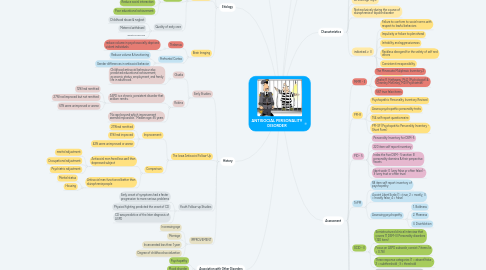
1. Prevalences
1.1. 2-3 % in the general population
1.2. 2-4 % in men and 0,5-1 % in women
1.3. Peaks in people age 24 to 44 years & drops off in people 45 to 64 years
2. Etiology
2.1. Genetic
2.1.1. Contribute 50%
2.1.1.1. Life course persistent offender (with CD)
2.2. Environmental
2.2.1. One/ both parents are antisocial
2.2.1.1. Poor parental management
2.2.1.2. Witness violence
2.2.1.3. Maltreatment
2.2.2. Watching TV
2.2.2.1. Observational learning
2.2.2.2. Increased risk of unemployee
2.2.2.3. Reduce social interaction
2.2.2.4. Poor educational achievement
2.2.3. Quality of early care
2.2.3.1. Childhood abuse & neglect
2.2.3.2. Maternal withdrwal
2.2.3.3. Quality of early care
2.3. Brain Imaging
2.3.1. Thalamus
2.3.1.1. reduce volume in psychosocially deprived violent individuals
2.3.2. Prefrontal Cortex
2.3.2.1. Reduce volume & functioning
2.3.2.2. Gender differences in antisocial behavior
3. History
3.1. Early Studies:
3.1.1. Glueks
3.1.1.1. Childhood antisocial behaviour also predicted educational achievement, economic status, employment, and family life in adulthood.
3.1.2. Robins
3.1.2.1. ASPD is a chronic, persistent disorder that seldom remits.
3.1.2.1.1. 12% had remitted
3.1.2.1.2. 27% had improved but not remitted
3.1.2.1.3. 61% were unimproved or worse
3.1.2.2. “No age beyond which improvement seemed impossible.” Median age=35 years
3.2. The Iowa Antisocial Follow-Up
3.2.1. Improvement:
3.2.1.1. 27%had remitted
3.2.1.2. 31% had improved
3.2.1.3. 42% were unimproved or worse
3.2.2. Comparison
3.2.2.1. Antisocial men fared less well than depressed subject
3.2.2.1.1. marital adjustment
3.2.2.1.2. Occupational adjustment
3.2.2.1.3. Psychiatric adjustment
3.2.2.2. Antisocial man functioned better than skizophrenia people
3.2.2.2.1. Marital status
3.2.2.2.2. Housing
3.3. Youth Follow-up Studies
3.3.1. Early onset of symptoms had a faster progression to more serious problems
3.3.2. Physical fighting predicted the onset of CD
3.3.3. CD was predictive of the later diagnosis of ASPD
3.4. IMPROVEMENT
3.4.1. Increasing age
3.4.2. Marriage
3.4.3. Incarcerated less than 1 year
3.4.4. Degree of childhood socialization
4. Association with Other Disorders
4.1. Psychopathy
4.2. Mood disorder
4.3. Seubstance abuse
5. Definition
5.1. Pattern of
5.1.1. Socially irresesponsible
5.1.2. Exploitative
5.1.3. Guiltness behavior
5.1.4. Disregard for
5.1.5. Violation of
6. Simptom
6.1. Failure to conform law
6.2. Failure to sustain consistent employment
6.3. Manipulation of others for personal gain
6.4. Decepttional of others
6.5. Failure to develop stable interpersonal relationship
7. Characteristics
7.1. 2-3 % in the general population
7.2. Occuring since 15y.o,
7.3. At least age 18y.o
7.4. Not exclusively during the course of skizophrenia or bipolar disorder
7.5. indicated ≥ 3
7.5.1. Failure to conform to social norms with respect to lawful behaviors
7.5.2. Impulisity or failure to plan ahead
7.5.3. Irritability and aggressiveness
7.5.4. Reckless disregard for the safety of self and others
7.5.5. Consistent irresponsibility
7.5.6. Lack of remorse
7.5.7. Deceitfulness
8. Assessment
8.1. MMPI - II
8.1.1. The Minessota Muliphasic Inventory 2
8.1.2. Starke R. Hathaway, Ph.D (Pychologist) &. Charnley McKinley, MD (Psychiatrist)
8.1.3. 567 true false items
8.2. PPI-R
8.2.1. Psychopathic Personality Inventory Revised
8.2.2. Assess psychopathic personality traits
8.2.3. 154 self report questionnaire
8.2.4. PPI-SF (Psychopathic Personality Inventory - Short Form)
8.3. PID - 5
8.3.1. Personality Inventory for DSM-5
8.3.2. 220 item self report inventory
8.3.3. Index the five DSM - 5 section III personality domains & their perpective facets
8.3.4. likert scale; 0 (very false or often false) - 3 (very true or often true)
8.4. TriPM
8.4.1. 58 item self report inventory of psychopathy
8.4.2. 4 point Likert Scale (1 = true, 2 = mostly, 3 = mostly false, 4 = false)
8.4.3. Assessing psychopathy
8.4.3.1. 1. Boldness
8.4.3.2. 2. Meaness
8.4.3.3. 3. Disinhibition
8.5. SCID - II
8.5.1. Semistructured clinical interview that covers 11 DSM-IV Personality disorders (120 item)
8.5.2. Focus on ASPD subscale, consist 7 items (α = 0.78)
8.5.3. Three response categories (1 = absent/false ; 2 = subthreshold ; 3 = threshold
8.6. CSS - M
8.6.1. Criminal Sentiments Scale Modified
8.6.2. 41- item self report
8.6.3. Measure composed of subscales reflecting procriminal attitudes
8.7. PID
8.7.1. Pride in Delinquency Scale
8.7.2. 10-item self-report
8.7.3. 21-point Likert-type scale
8.7.4. Higher score indicates that an individual would be prouder to engage in the antisocial acts
8.8. The YLS/CMI
8.8.1. Youth Level of Service/ Case Management Inventory
8.8.2. Assess youths’ criminogenic needs and estimate their risk to reoffend
8.8.3. 42 Items, assesses 8 categories of criminogenic factors

